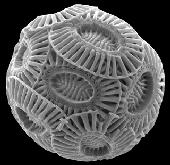|
 See More Images See More Images
(1 total)

Emiliania huxleyi
© 2003 Jeremy R. Young, Natural History Museum, London
|
What are Calcareous Nannoplankton? The calcareous nannoplankton are unicellular photosynthetic protists, members of the group Haptophyta. They may take on many different shapes, but all have shells composed of tiny, calcium carbonate plates called “coccoliths.” These tiny plankton are found mostly in tropical marine environments and are important primary producers. After the organisms die, their coccoliths accumulate on the bottom of the ocean, forming calcareous oozes that can harden into chalks and other fine-grained limestones. Fossils of calcareous nannoplankton have been found in limestones and chalks since the Jurassic. First known fossil occurrence: Jurassic. Last known fossil occurrence: Quaternary. This group has living relatives. Cool Calcareous Nannoplankton links: Search for images of Calcareous Nannoplankton on Google |
See Calcareous Nannoplankton from the:
|
|




